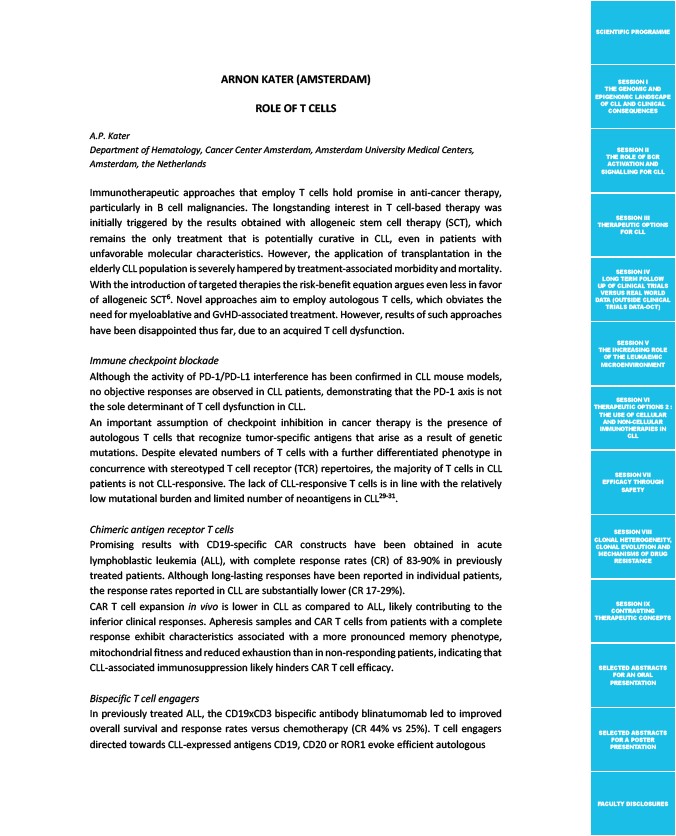
SCIENTIFIC PROGRAMME
SESSION I
THE GENOMIC AND
EPIGENOMIC LANDSCAPE
OF CLL AND CLINICAL
CONSEQUENCES
SESSION II
THE ROLE OF BCR
ACTIVATION AND
SIGNALLING FOR CLL
SESSION III
THERAPEUTIC OPTIONS
FOR CLL
SESSION IV
LONG TERM FOLLOW
UP OF CLINICAL TRIALS
VERSUS REAL WORLD
DATA (OUTSIDE CLINICAL
TRIALS DATA-OCT)
SESSION V
THE INCREASING ROLE
OF THE LEUKAEMIC
MICROENVIRONMENT
SESSION VI
THERAPEUTIC OPTIONS 2 :
THE USE OF CELLULAR
AND NON-CELLULAR
IMMUNOTHERAPIES IN
CLL
SESSION VII
EFFICACY THROUGH
SAFETY
SESSION VIII
CLONAL HETEROGENEITY,
CLONAL EVOLUTION AND
MECHANISMS OF DRUG
RESISTANCE
SESSION IX
CONTRASTING
THERAPEUTIC CONCEPTS
SELECTED ABSTRACTS
FOR AN ORAL
PRESENTATION
SELECTED ABSTRACTS
FOR A POSTER
PRESENTATION
FACULTY DISCLOSURES
ARNON KATER (AMSTERDAM)
ROLE OF T CELLS
A.P. Kater
Department of Hematology, Cancer Center Amsterdam, Amsterdam University Medical Centers,
Amsterdam, the Netherlands
Immunotherapeutic approaches that employ T cells hold promise in anti-cancer therapy,
particularly in B cell malignancies. The longstanding interest in T cell-based therapy was
initially triggered by the results obtained with allogeneic stem cell therapy (SCT), which
remains the only treatment that is potentially curative in CLL, even in patients with
unfavorable molecular characteristics. However, the application of transplantation in the
elderly CLL population is severely hampered by treatment-associated morbidity and mortality.
With the introduction of targeted therapies the risk-benefit equation argues even less in favor
of allogeneic SCT6. Novel approaches aim to employ autologous T cells, which obviates the
need for myeloablative and GvHD-associated treatment. However, results of such approaches
have been disappointed thus far, due to an acquired T cell dysfunction.
Immune checkpoint blockade
Although the activity of PD-1/PD-L1 interference has been confirmed in CLL mouse models,
no objective responses are observed in CLL patients, demonstrating that the PD-1 axis is not
the sole determinant of T cell dysfunction in CLL.
An important assumption of checkpoint inhibition in cancer therapy is the presence of
autologous T cells that recognize tumor-specific antigens that arise as a result of genetic
mutations. Despite elevated numbers of T cells with a further differentiated phenotype in
concurrence with stereotyped T cell receptor (TCR) repertoires, the majority of T cells in CLL
patients is not CLL-responsive. The lack of CLL-responsive T cells is in line with the relatively
low mutational burden and limited number of neoantigens in CLL29-31.
Chimeric antigen receptor T cells
Promising results with CD19-specific CAR constructs have been obtained in acute
lymphoblastic leukemia (ALL), with complete response rates (CR) of 83-90% in previously
treated patients. Although long-lasting responses have been reported in individual patients,
the response rates reported in CLL are substantially lower (CR 17-29%).
CAR T cell expansion in vivo is lower in CLL as compared to ALL, likely contributing to the
inferior clinical responses. Apheresis samples and CAR T cells from patients with a complete
response exhibit characteristics associated with a more pronounced memory phenotype,
mitochondrial fitness and reduced exhaustion than in non-responding patients, indicating that
CLL-associated immunosuppression likely hinders CAR T cell efficacy.
Bispecific T cell engagers
In previously treated ALL, the CD19xCD3 bispecific antibody blinatumomab led to improved
overall survival and response rates versus chemotherapy (CR 44% vs 25%). T cell engagers
directed towards CLL-expressed antigens CD19, CD20 or ROR1 evoke efficient autologous